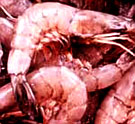Just above the high-tide mark on the coast of northern Mexico, elegant fingers of pitaya cacti rise far above the surrounding mesquite trees. Roseate spoonbills and frigatebirds sail silently overhead, a dolphin skirts the tangle of mangroves near the shore, and a fishing boat sputters out to the Sea of Cortez. On this muggy, almost unbearably hot slice of Sonoran coastline, sunset can be the most dramatic thing that happens all day.

Sunset over the Sea of Cortez.
Or that, at any rate, was how life was before the bulldozers arrived. Speculators have demolished more than 1,000 acres of cactus forest on the edge of this enormous, mazelike estuary, replacing the prickly old growth with clusters of brackish ponds. The ponds are designed to produce yearly crops of plump shrimp, raised on fishmeal and destined for all-you-can-eat buffets in the United States.
Some of the people who live in the region are delighted by these changes. “We’ve never had a stable way to make a living,” says Poli Gastlum, a dignified oyster fisher and a longtime resident of a collective farming village called Ejido Las Agilas. “We’ve seen the numbers for shrimp farming, we know how much money it can make. This is going to work.”
Maybe. Since the World Bank underwrote the first Southeast Asian shrimp operations a generation ago, almost every country with a frost-free coastline has been hit by the fever for pink gold. But the industry has turned out to be a questionable investment and an almost unrelieved environmental nightmare: Shrimp farms have destroyed millions of acres of coastal cactus and mangrove forests, and they’ve turned many of the world’s pristine estuaries into shrimp toilets. In Mexico, where small communities often welcome shrimp farms into the neighborhood, the number of shrimp producers nearly doubled between 1993 and 1998. Shrimp ponds now cover more than 50,000 acres of the country’s west coast, and the development shows no signs of slowing.
A Jumbo Shrimp Problem
Get-rich-quick dreams have long tantalized the people of the southern Sonoran coast. In the early 1970s, the Mexican government created hundreds of ejidos, or land collectives, within a few miles of the Sea of Cortez. Thousands of people arrived from mountain mining towns, all drawn by the promise of a stable farming life. But most of the land set aside for the ejidos has little or no water, making small-scale farming a very tough go.

Shrimp in a pen.
Photo: NOAA.
“People are tired of not having work,” says Lupita Mendivil, who lives in Ejido Las Agilas with her family. “They’re saying, ‘Vamonos, let’s go for aquaculture.'”
Some ejidos have sold their collectively owned land to shrimp-farm big shots. Others, such as Ejido Las Agilas, hope to enter into joint shrimp-farming ventures with Mexican or foreign investors. A few ejidos have turned a profit this way: One joint venture earned more than half a million dollars in 1999.
But the business is risky. About a quarter of Mexico’s shrimp farms have been shut down by disease outbreaks or other problems in recent years, and earnings have been erratic. A recent report to a group of international organizations, including the World Bank and the United Nations Food and Agriculture Organization, says some Mexican farms are little more than money-laundering operations for drug dealers.
Lalo Mendivil, Lupita’s brother, has spent most of his life fishing near the tiny coastal village of Navopatia. He understands the high hopes of the people in Las Agilas, but he worries that the shrimp-farming boom will threaten his livelihood.

Shrimp, shrimp on the range.
Photo: NOAA.
The estuary where Mendivil fishes is already polluted by agricultural runoff, and he says the shrimp operations will only make the situation worse. There are few state or federal environmental controls on shrimp farms, and shrimp-farm waste is often dumped directly into the ocean.
“We need work, but this shrimp business is worse than nothing,” he says. A 1,000-acre farm might employ four people, he says, but in the long term it might kill off enough fish to put 100 fishers out of work.
Mendivil isn’t alone in his outrage; in several places along the coast, angry platoons of fishers have filled shrimp-farm waste canals with shovelfuls of sand and gravel.
Ibrael Lopez Espinoza, who grew up in Ejido Las Agilas but works as a lab technician in a nearby city, is torn by the shrimp-farming business. He’d love to be able to make a living in his hometown, but he worries about the impact of a shrimp farm on the nearby estuary.”In many cases, the bosses haven’t respected the rules,” he says. “I’m an environmentalist, and, God willing, I can make sure we learn from these bad examples.”
Prawn Shop
Espinoza is not the only environmentalist who believes the shrimp-farming industry can be reformed. In the late 1990s, shrimp farming attracted publicity as a classic example of free trade run amok. Several countries — among them India, Honduras, and Ecuador — tried to rein in the shrimp-farming expansion, and financial troubles convinced the industry to accept a few restrictions. The publicity has quieted down, but grassroots activists in shrimp-farming countries have continued to criticize the industry, and a few North American and international groups have kept up the pressure.

A shrimp trawler.
Photo: NOAA.
Some activists say shrimp farming is ready for big, industry-wide improvements. Jason Clay of the World Wildlife Fund wasn’t too interested in shrimp until 1996, when he started comparing the impacts of shrimp farming and open-ocean shrimp trawling. After deciding that farming was a lot more “fixable” than trawling, he spent three years traveling the world, investigating the best and the worst of shrimp farming.
“Shrimp is still worth more than any other agricultural commodity,” he says. “The industry isn’t going away, but we can make it something we can live with.” To that end, Clay is helping to develop an international certification system for farmed shrimp, one that will include hard-and-fast rules about habitat protection, pollution control, and fair treatment of workers.
Members of a United Nations subcommittee on aquaculture support the idea of a certification plan, and Clay hopes shrimp-farming countries can agree on standards within a couple of years.

Pink gold.
Photo: U.S. EPA.
There are already a few examples of kinder and gentler shrimp farming. One farm in Colombia has replanted large stands of mangroves, and is using them as a natural filter for farm waste. Thanks in part to pressure from Environmental Defense, the state of Texas requires its shrimp farms to clean their discharged water and keep a tight lid on disease outbreaks.
But all this isn’t of much immediate help to the cactus forests of western Mexico — or to coastal dwellers like Julio Garcia Ussher. When Garcia Ussher retired from a career in the Mexican seafood industry, he moved to his family’s cattle ranch on the southern Sonoran coast. He thought he’d spend a few years being the ranch’s caretaker, just to enjoy the quiet and the proximity of the sea.
Over the past two years, more than 250 acres of private land around Garcia Ussher’s ranch have been razed. Cacti and mesquite lie stacked on the bare ground, forming long rows that some locals call chorizos, or sausages. Garcia Ussher misses his desert vistas, but he’s not surprised at their disappearance. He spent a year working for Ocean Garden, a state-owned company that is Mexico’s largest processor and exporter of farmed shrimp, and he knows how this business works.
“When the people who own these projects see places like this,” says Ussher, “they say, ‘What’s here? Nada. Who’s going to protest? Nadie.”

